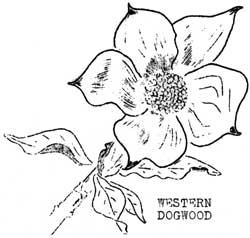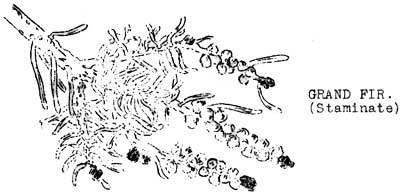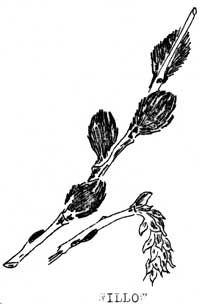
|

"And all the meadows,
wide unrolled,
Were green and silver,
green and gold,
Where buttercups and
daisies spun
Their shining tissues
in the sun" (Dorr)
|

|
When spring, with its colorful flowers of field and wood, finally
does arrive we are apt to overlook the interest in tree flowers. Many
common trees of course, like the apple, willow, etc., share in the glory
of the spring floral display but the flowers of the great majority of
trees are "borne to blush unseen" and unappreciated. Many, however, have
interesting, distinctive and beautiful flowers such as our own Western
Dogwood (Cornus nuttallii). One cannot question the beauty embodied in
this tree when in full bloom. Unfortunately, it is found only in a
limited area within the park - and there it occurs but sparingly.
Related to the diminutive Canadian Dogwood (Cornus canadensis), an
herbacious plant of the deep forests it is similar in flower structure.
The ivory "petals" which are so conspicuous are, instead bracts or
modified leaves. The flowers are contained in the compact cluster which
these bracts surround.
|


One of the first harbingers of spring are the furry catkins of the
willow. No one has to be told that the "pussy" willows are but clusters
of minute staminate flowers. As the season advances their furry
character is supplanted by the appearance of the stamens which have
finally pushed from the protective shelter of the furry scales which had
protected them earlier in the season. Bearing their yellow pollen upon
the ends of these stamens the catkins then resemble bunches of golden
beads. In addition are the pistillate catkins, borne upon different
willow trees or shrubs, green and not so interesting in appearance. But
each type of willow flower is possessed of a feature that is necessary
to the existence of the species. At the base of each flower is a smaller
nectar gland which serves to attract large numbers of bees at this early
season and thereby, as they visit first one and then another willow,
serve to pollenize the plants. Thirteen species of willows are native to
Mt. Rainier National Park while approximately 175 species are known.
In the case of the alders, of which but two species are native to the
park, both staminate and pistillate flowers are partially developed
during the preceding summer. In the spring the staminate flowers, which
are terminal on the branchlets and erect in the winter, develop into
long pendant catkins which eventually shake themselves out to loose the
pollen to the breeze by which it is carried about. These loose pendant
catkins are very conspicuous in the park during early spring.
An added charm is given to many of our conifers at this season. In
the case of the Douglas fir (Pseudotsuga taxifolia) its sombre green is
enlivened by the reddish purple pistillate flowers that will, by late
summer, develop into the characteristic cones. The staminate flowers are
found near the ends of the branchlets - being clusters of small oblong
bodies which are a tan or light brown in color. In the case of the Grand
Fir (Abies grandis) the staminate flowers, found at the ends of the
branchlets, are a grey-brown in color. (See illustration on page 12)

Then we have the Maple, represented in the park by three species.
Only one of these three can be considered a tree and this, the Broadleaf
Maple (Acer macrophyllum), is festooned in the spring with long racemes
of pendant, greenish-yellow flowers that appear after the leaves. This
is a common deciduous tree throughout the northwest, as is the Black
Cottonwood, another of the parks few deciduous species. Anyone who has
lived close by any number of these trees can well appreciate the
appropriate character of its common name for the air, after maturity of
the seeds is filled with countless tufts of white "fuzz" which are
really seeds attached to a light hairy parachute arrangement which
utilizes the air currents in transporting the seeds to places where they
may take root. As it is a member of the same family as the willow you
will expect to find staminate flowers on some trees and pistillate
flowers on others - and this is true. The Black Cottonwood's staminate
flowers are densely arranged in long, pendant clusters, its units being
flat and disk-like while the pistillate are small bead-like bodies,
which are also borne in long loose clusters, that may be readily seen
upon the ground in the late spring after a windstorm.
So look to the trees in your locality for flower interest! The oak,
ash, elm, beech, chestnut, magnolia, sycamore, locust, horse-chestnut,
catalpa, and many others which are not represented in the almost wholly
coniferous forests of this park offer interesting possibilities for
study. (CFB)

